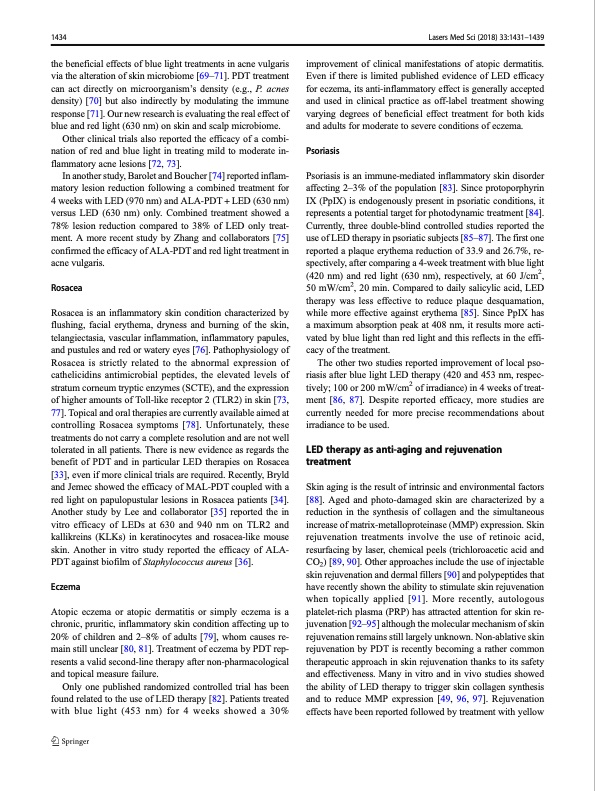
PDF Publication Title:
Text from PDF Page: 004
1434 Lasers Med Sci (2018) 33:1431–1439 the beneficial effects of blue light treatments in acne vulgaris via the alteration of skin microbiome [69–71]. PDT treatment can act directly on microorganism’s density (e.g., P. acnes density) [70] but also indirectly by modulating the immune response [71]. Our new research is evaluating the real effect of blue and red light (630 nm) on skin and scalp microbiome. Other clinical trials also reported the efficacy of a combi- nation of red and blue light in treating mild to moderate in- flammatory acne lesions [72, 73]. In another study, Barolet and Boucher [74] reported inflam- matory lesion reduction following a combined treatment for 4 weeks with LED (970 nm) and ALA-PDT + LED (630 nm) versus LED (630 nm) only. Combined treatment showed a 78% lesion reduction compared to 38% of LED only treat- ment. A more recent study by Zhang and collaborators [75] confirmed the efficacy of ALA-PDT and red light treatment in acne vulgaris. Rosacea Rosacea is an inflammatory skin condition characterized by flushing, facial erythema, dryness and burning of the skin, telangiectasia, vascular inflammation, inflammatory papules, and pustules and red or watery eyes [76]. Pathophysiology of Rosacea is strictly related to the abnormal expression of cathelicidins antimicrobial peptides, the elevated levels of stratum corneum tryptic enzymes (SCTE), and the expression of higher amounts of Toll-like receptor 2 (TLR2) in skin [73, 77]. Topical and oral therapies are currently available aimed at controlling Rosacea symptoms [78]. Unfortunately, these treatments do not carry a complete resolution and are not well tolerated in all patients. There is new evidence as regards the benefit of PDT and in particular LED therapies on Rosacea [33], even if more clinical trials are required. Recently, Bryld and Jemec showed the efficacy of MAL-PDT coupled with a red light on papulopustular lesions in Rosacea patients [34]. Another study by Lee and collaborator [35] reported the in vitro efficacy of LEDs at 630 and 940 nm on TLR2 and kallikreins (KLKs) in keratinocytes and rosacea-like mouse skin. Another in vitro study reported the efficacy of ALA- PDT against biofilm of Staphylococcus aureus [36]. Eczema Atopic eczema or atopic dermatitis or simply eczema is a chronic, pruritic, inflammatory skin condition affecting up to 20% of children and 2–8% of adults [79], whom causes re- main still unclear [80, 81]. Treatment of eczema by PDT rep- resents a valid second-line therapy after non-pharmacological and topical measure failure. Only one published randomized controlled trial has been found related to the use of LED therapy [82]. Patients treated with blue light (453 nm) for 4 weeks showed a 30% improvement of clinical manifestations of atopic dermatitis. Even if there is limited published evidence of LED efficacy for eczema, its anti-inflammatory effect is generally accepted and used in clinical practice as off-label treatment showing varying degrees of beneficial effect treatment for both kids and adults for moderate to severe conditions of eczema. Psoriasis Psoriasis is an immune-mediated inflammatory skin disorder affecting 2–3% of the population [83]. Since protoporphyrin IX (PpIX) is endogenously present in psoriatic conditions, it represents a potential target for photodynamic treatment [84]. Currently, three double-blind controlled studies reported the use of LED therapy in psoriatic subjects [85–87]. The first one reported a plaque erythema reduction of 33.9 and 26.7%, re- spectively, after comparing a 4-week treatment with blue light (420 nm) and red light (630 nm), respectively, at 60 J/cm2, 50 mW/cm2, 20 min. Compared to daily salicylic acid, LED therapy was less effective to reduce plaque desquamation, while more effective against erythema [85]. Since PpIX has a maximum absorption peak at 408 nm, it results more acti- vated by blue light than red light and this reflects in the effi- cacy of the treatment. The other two studies reported improvement of local pso- riasis after blue light LED therapy (420 and 453 nm, respec- tively; 100 or 200 mW/cm2 of irradiance) in 4 weeks of treat- ment [86, 87]. Despite reported efficacy, more studies are currently needed for more precise recommendations about irradiance to be used. LED therapy as anti-aging and rejuvenation treatment Skin aging is the result of intrinsic and environmental factors [88]. Aged and photo-damaged skin are characterized by a reduction in the synthesis of collagen and the simultaneous increase of matrix-metalloproteinase (MMP) expression. Skin rejuvenation treatments involve the use of retinoic acid, resurfacing by laser, chemical peels (trichloroacetic acid and CO2) [89, 90]. Other approaches include the use of injectable skin rejuvenation and dermal fillers [90] and polypeptides that have recently shown the ability to stimulate skin rejuvenation when topically applied [91]. More recently, autologous platelet-rich plasma (PRP) has attracted attention for skin re- juvenation [92–95] although the molecular mechanism of skin rejuvenation remains still largely unknown. Non-ablative skin rejuvenation by PDT is recently becoming a rather common therapeutic approach in skin rejuvenation thanks to its safety and effectiveness. Many in vitro and in vivo studies showed the ability of LED therapy to trigger skin collagen synthesis and to reduce MMP expression [49, 96, 97]. Rejuvenation effects have been reported followed by treatment with yellowPDF Image | Photodynamic and photobiological effects of (LED) therapy

PDF Search Title:
Photodynamic and photobiological effects of (LED) therapyOriginal File Name Searched:
10103_2018_Article_2584.pdfDIY PDF Search: Google It | Yahoo | Bing
Cruise Ship Reviews | Luxury Resort | Jet | Yacht | and Travel Tech More Info
Cruising Review Topics and Articles More Info
Software based on Filemaker for the travel industry More Info
The Burgenstock Resort: Reviews on CruisingReview website... More Info
Resort Reviews: World Class resorts... More Info
The Riffelalp Resort: Reviews on CruisingReview website... More Info
| CONTACT TEL: 608-238-6001 Email: greg@cruisingreview.com | RSS | AMP |